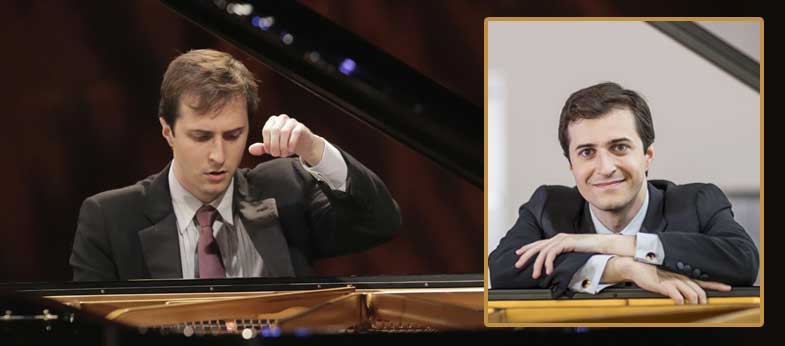
About
Stepping in for the originally announced Michel Dalberto who had to cancel his U.S. tour, Broberg comes to Steinway Society feted from his recent Cliburn Silver Medal win where he wowed the audience with performances that showed “an imaginative shaping of themes, revelation of inner voices, and an unfailing sense of momentum” (Texas Classical Review). He was also a medalist in the Hastings (1st), Dallas (1st), Sydney, Seattle, and New Orleans International Piano Competitions. He has performed with the Royal Philharmonic Orchestra, the Sydney Symphony, and the Seattle Symphony, among others.
Decca Gold label has just released Mr. Broberg’s second CD, which features some of his Cliburn Competition performances. His solo, chamber, and concerto performances have been broadcast on NPR and ABC (Australia) radio. His next concerts take place across the US, in the United Kingdom and Italy.
Mr. Broberg began studying piano at age six. He resides in Parkville, Missouri, where he studies with 2001 Cliburn gold medalist Stanislav Ioudenitch.
Program
Program Notes
Despite being a piano prodigy, César Franck did not compose many works for the piano. He withdrew from public piano performance in the mid-1840s, devoting himself instead to composition and to a succession of increasingly important posts as organist. When the three-manual Cavaillé-Coll organ was completed in 1859 at Sainte-Clotilde in Paris, where Franck was choirmaster, he was inspired to compose Six pièces pour le grand orgue, completing them in 1862. The third of the pieces, the Prelude, Fugue, and Variation, Op. 18, was transcribed for piano in 1910 by the English-born violinist and pianist, Harold Bauer (who coincidentally also performed the world premiere of Debussy’s Children’s Corner, also on today’s program).
The plaintive B-minor theme of the Prelude—one of the most haunting that Franck wrote—unfolds over a stately bass in stepwise descending motion. After a short Lento transition, a stark Fugue follows. Although Franck’s use of the terms prelude and fugue pays homage to Bach, the work’s themes are firmly set in the Romantic era. The three-voiced Variation returns to the plaintive cantilena of the Prelude, in great reverence and repose closing gently in the parallel major key.
The Toccata in C minor bears the hallmarks of a youthful work of a great master. Though Bach’s seven toccatas for harpsichord are undated, it is believed that they arose during his years in Arnstadt or after his return to Weimar, thus dating sometime between 1703 and 1717. The work takes as its model the North German style toccatas of Buxtehude, with its alternation between improvisatory passages that display the performer’s virtuosity and sections of imitative counterpoint. The first 12 measures exhibit virtuosic display with scales and arpeggios in 16th and 32nd notes. The fugal sections, separated by only a few intermediate bars, lack the greater formality of Bach’s later fugal works. The piece ends with a slow section followed by a rapid finale, both in a free-composed form. [Adapted from Valle N., https://www.allmusic.com/composition/toccata-for-keyboard-in-c-minor-bwv.]
Claude Debussy wrote the suite Children’s Corner in 1908 for his three-year-old daughter, Claude-Emma (“Chou-Chou”), to whom it is dedicated. The title “Doctor Gradus ad Parnassum” alludes to Fux’s Gradus ad Parnassum, one of the most important treatises on counterpoint, and pokes gentle fun at Clementi’s book of exercises of the same name. “Jimbo’s Lullaby” recalls an elephant that was briefly a Parisian attraction. A porcelain doll comes to life in “Serenade of the Doll,” which employs the pentatonic scale. “The Snow Is Dancing” paints a melancholy portrait of falling snowflakes in hushed, semi-detached notes. “The Little Shepherd” depicts a shepherd playing his flute. “Golliwogg’s Cakewalk” evokes a minstrel strutting to ragtime accompaniment, punctuated by the strumming of a banjo; it also contains several short references to the Liebestod (love-death) motif from Wagner’s Tristan und Isolde. (A golliwogg is a stuffed black doll with red pants, bow tie, and wild hair, reminiscent of black-face minstrels of the time.)
Few musicians would dispute that Liszt’s Sonata in B minor is one of the 19th century’s greatest masterpieces. Liszt dedicated it to Robert Schumann, who, having already been committed to an asylum, never heard it. Clara Schumann received a copy in 1854 shortly after its publication, but loathed the work (and Liszt himself!): “merely a blind noise—no healthy ideas anymore, everything confused, one cannot find a single, clear harmonic progression—and yet I must thank him for [the dedication to Robert]. It really is too awful.” The sonata was premiered in 1857 in Berlin by Hans von Bülow, one of the century’s greatest pianists; he married Liszt’s daughter Cosima that year. The work was received joyfully by many of Liszt’s contemporaries; Wagner (himself the future second husband of Cosima) wrote in 1855 that the work was “deep and noble.” Critics, however, were sometimes not as complimentary.
Though in one movement, the work follows sonata form, prompting Liszt biographer Alan Walker to call it a “sonata within a sonata.” Three of the five main themes are presented early in the first section, providing the pianist a variety of material, from descending scales to staccato octaves to legato melodies. The lack of separation between sections gave rise to much controversy and criticism in the 19th century. The work remains somewhat controversial, in part due to an accretion of performance practices not supported by the score.
Today, the sonata is the source of analysis and debate, not just for its interesting harmonies and compositional techniques, but also for its possible symbols and meaning, with theories ranging from descriptions of the divine and diabolical to portraits of Faust, Gretchen, and Mephistopheles.